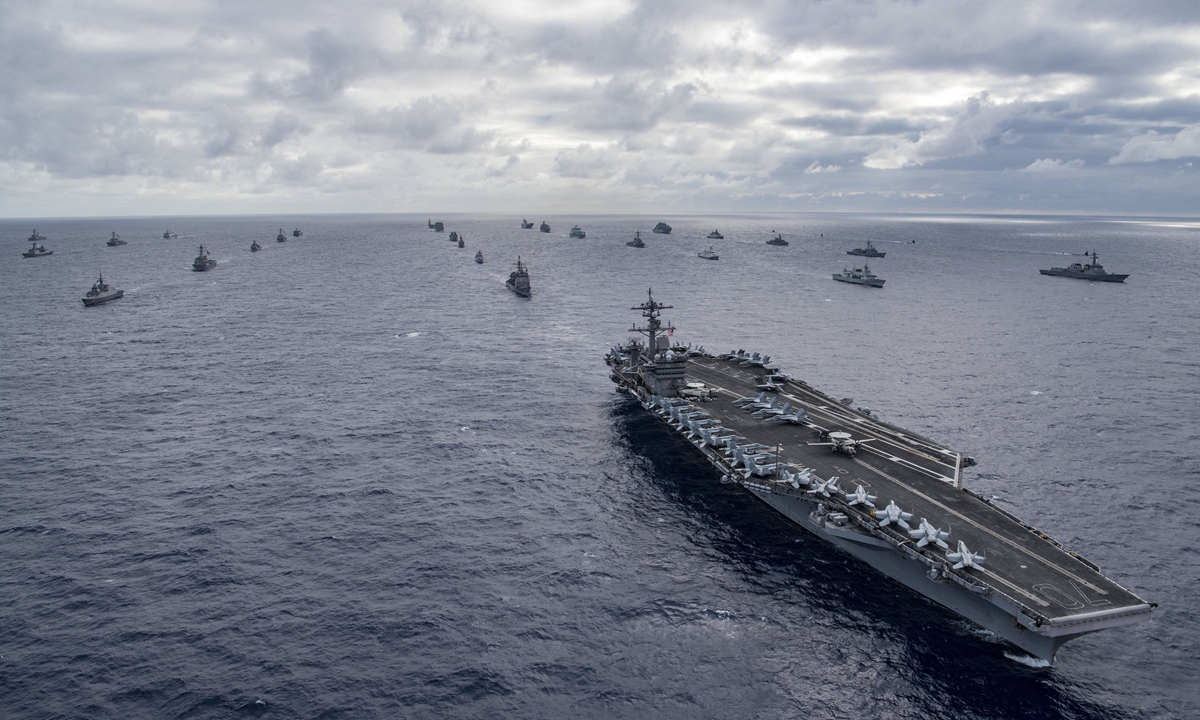
International Navy ships assemble for a photo exercise off the coast of Hawaii during the Rim of Pacific Exercise (RIMPAC) 2018, on July 26, 2018 in the Pacific Ocean. Photo: AFP
Washington, which is busy with the "diplomatic show" of the G7 and NATO summits at the Atlantic Ocean, launched a "military show" in the Pacific Ocean. The RIMPAC (Rim of the Pacific) 2022 led by the US began on June 29 and will continue until August 4. This year, a total of more than 25,000 personnel from 26 countries are participating in the world's largest multinational maritime military exercise and the deployment of unmanned systems, fighter jets, and large-scale warships has reportedly set a record.
The RIMPAC was a product of the Cold War, and the imaginary enemy at that time was the Soviet Union. Some US media said the target of RIMPAC is self-evident, which is China that has not been invited. Many American and Western analysts have said this military exercise is to send a message to China - "China's expansion in the West Pacific region will be obstructed and defeated." Perhaps they wish to rename the "Rim of the Pacific" to the "Rim of China" to better deter China. But everyone knows that this is self-deceit of the US and several of its followers, and it does not represent the collective attitude of the 26 countries participating in the exercise.
A Southeast Asian military officer who participated in the exercise likened the RIMPAC to a party at sea. It must be the real thought of many participating countries. From another point of view, this shows that they are only here to participate in a party, not to be drawn as a member to oppose or confront another country. It is not difficult to see that most countries are consciously keeping a distance from the anti-China actions of the US. This constitutes a paradox: the bigger the scale of RIMPAC and the more countries participating, the more the directionality and the military and political significance expected by Washington will be weakened. It is turning into more of a farce.
The target newly set up by the US for the RIMPAC is a false one. Where does "China's expansion in the West Pacific region" come from? One only sees that the US is increasing its intervention in the region. This time, the US invited a number of South China Sea claimant countries. Its intention to stir up trouble and sow discord in the South China Sea is obvious. But few countries are willing to follow Washington in the muddy waters of "geopolitical competition."
The Russia-Ukraine conflict has given Washington more excuses to get its hands on the Pacific. The US Navy's press release publicly declared that the military exercise aims to "deter and defeat aggression by major powers across all domains and levels of conflict," which is almost a replica of Tokyo's so-called "Ukraine today, Taiwan Straits tomorrow" rhetoric. However, in the past few years, NATO conducted numerous military exercises and deterrence against Russia, which only intensified contradictions but did not "frighten" anyone. What's more, the situation around the Taiwan question is completely different. No matter how much bluffing external forces make, their speculative mentality in the Taiwan Straits is vulnerable to the will and determination of the Chinese People's Liberation Army.
Unlike in the past when the joint exercises were mostly attended by Pacific countries, nearly half of the 26 countries participating in this year's exercise are NATO members or partners. Japan and South Korea, which were just invited to participate in the NATO Summit as the bloc's partner countries in the Asia-Pacific region, have shown an active attitude this time. South Korea not only sent its largest military force since its first participation in the exercise in 1990, its amphibious assault ship ROKS Marado will also be deployed. The participation of Japan's destroyer Izumo for the first time after it was converted into a light aircraft carrier is also eye-catching. The greatest destructiveness of the RIMPAC is reflected in the poisoning of the atmosphere of regional peace, and the eventual degree of damage will depend on the immunity of countries in the Asia-Pacific region to the US Cold War clamor.
Although it wants to use "great power competition" to muddy the waters of the Pacific Ocean, the hegemonic power of the US is limited, so it uses the method of "wooing one faction and fighting another." As long as most countries do not follow the US, its various irresponsible behaviors will face more constraints. Otherwise, the atmosphere for peace and development, not only in the Asia-Pacific region, but even the world, will be ruined by the US. Regional countries and even the international community must always maintain a high degree of vigilance toward this as well as toward the RIMPAC.




